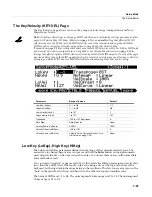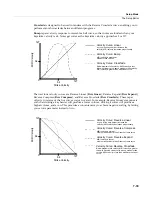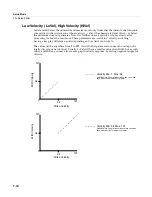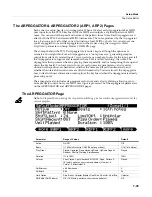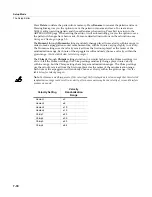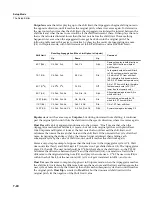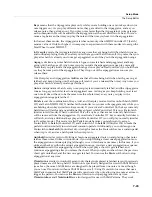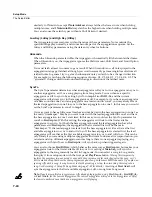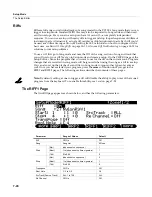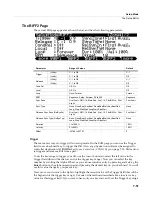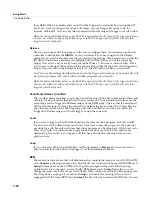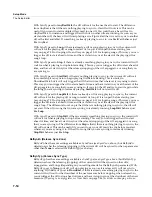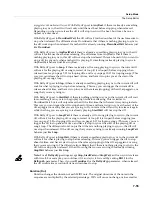
7-40
Setup Mode
The Setup Editor
Unipolar
means
that
after
playing
up
to
the
shift
limit,
the
Arpeggiator
begins
shifting
notes
in
the
opposite
direction,
until
it
reaches
the
original
pitch,
where
it
reverses
again.
To
determine
the
next
note
when
it
reaches
the
shift
limit,
the
Arpeggiator
calculates
the
interval
between
the
shift
limit
and
what
the
next
note
would
be
if
the
shift
limit
weren’t
there.
It
then
plays
the
note
that
is
the
calculated
interval
lower
than
the
last
note
before
the
shift
limit.
The
same
thing
happens
in
reverse
when
the
arpeggiated
notes
get
back
down
to
the
original
pitch.
The
following
table
makes
this
easier
to
visualize
by
showing
the
result
of
arpeggiating
one
note
(C4)
in
Unipolar
mode,
with
Shift
Amount
set
to
3
ST
and
various
values
for
Shift
Limit.
Bipolar
starts
out
the
same
way
as
Unipolar
,
but
during
downward
note
shifting,
it
continues
past
the
original
pitch
until
it
hits
the
shift
limit
in
the
opposite
direction,
where
it
reverses
again.
Float
Res
adds
a
bit
of
apparent
randomness
to
the
process.
“Float”
means
that
when
the
Arpeggiator
reaches
the
shift
limit,
it
resets—but
not
to
its
original
pitch
as
with
plain
Reset.
Like
Unipolar
and
Bipolar,
it
looks
at
the
first
note
that
would
exceed
the
shift
limit,
and
calculates
the
interval
between
that
note
and
the
shift
limit.
It
then
restarts
the
cycle
of
latched
notes,
transposing
the
entire
cycle
by
the
interval
it
just
calculated,
then
shifting
each
subsequent
cycle
by
the
value
of
Shift
Amount,
until
it
reaches
the
shift
limit
again.
Here’s
a
very
simple
example.
Suppose
that
the
only
note
in
the
Arpeggiator
cycle
is C4,
Shift
Amount
is
4
(a
third),
and
Shift
Limit
is
7
(so
notes
won’t
get
shifted
above
G4).
The
Arpeggiator
plays
C4,
then
E4.
The
next
note
should
be
G
#
4,
but
that’s
above
the
shift
limit—so
the
PC3LE
calculates
the
difference
between
that
G
#
4
and
the
shift
limit
(G4):
one
semitone.
It
adds
that
difference
to
the
original
starting
note
(C4)
and
plays
that
note
next—C
#
4.
The
next
note
(F4)
is
within
the
shift
limit,
but
the
next
note
(A4)
isn’t,
so
it
gets
translated
into
D4—and
so
on.
Float
Uni
uses
the
same
concept
and
applies
it
to
Unipolar
mode:
when
the
Arpeggiator
reaches
the
shift
limit,
it
calculates
the
difference
between
the
next
note
and
the
limit,
and
transposes
the
next
cycle
of
notes
down
by
that
interval,
then
shifts
each
subsequent
cycle
down
until
it
reaches
the
original
pitch.
Float
Bip
is
similar
to
Float
Uni
,
but
the
downward
shift
limit
isn’t
the
original
pitch,
it’s
the
negative
of
the
Shift
Limit
value.
Shift Limit
Resulting Arpeggiation (When LimitOption is Unipolar)
Comment
Up
Down
Up
6 ST (F#4)
C4, D
#
4, F
#
4, D
#
4, C4
D#4, …
Same notes play in both directions
when Shift Limit is a multiple of
Shift Amount
7 ST (G4)
C4, D
#
4, F
#
4, E4,
C
#
4,
D
#
4, …
Last upward note before shift limit
is F#4, next upward note would be
A4, which is 2 ST from shift limit
(G4); therefore first downward note
is E4 (2 ST below last upward note)
8 ST (G
#
4)
C4, D
#
4, F
#
4,
F4, D4,
D
#
4, …
A4 is 1 ST from shift limit, therefore
first downward note is F4 (1 ST
lower than last upward note)
9 ST (A4)
C4, D
#
4, F
#
4, A4
F
#
4, D
#
4, C4,
D#4, …
All symmetrical again; now A4 is
within shift limit
10 ST (A#4)
C4, D
#
4, F
#
4, A4,
G4, E4, C
#
4,
D
#
4, …
Next upward note would be C5,
which is 2 ST from shift limit
11 ST (B4)
C4, D
#
4, F
#
4, A4,
G
#
4, F4, D4,
D
#
4, …
C5 is 1 ST from shift limit
12 ST (C5)
C4, D
#
4, F
#
4, A4, C5,
A4, F
#
4, D
#
4, C4,
D#4, …
Symmetrical again, including C5
Summary of Contents for PC3LE
Page 14: ...x...
Page 28: ...2 10 Startup Software Upgrades...
Page 42: ...3 14 User Interface Basics Quick Song Recording and Playback...
Page 46: ...4 4 The Operating Modes Using the Modes...
Page 196: ...8 4 Quick Access Mode The QA Editor...
Page 226: ...9 30 Master Mode UTILITIES...
Page 260: ...10 34 Song Mode and the Song Editor Song Editor The EVENT Page...
Page 272: ...11 12 Storage Mode Format...
Page 286: ...12 14 Keymap and Sample Editing Editing Samples...


